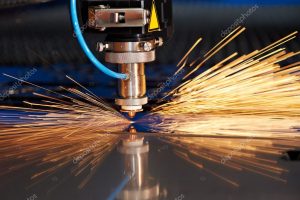 CNC automated laser cutters can be employed to cut a variety of materials. Still, to do so effectively, fabricators must first establish the laser cutting power needed in relation to the type of material to be cut. Why? Each material has its own set of properties and thicknesses desired for the fabrication of certain products, and the approach to cutting them differs with each. To ensure efficient cuts, laser cutting power, defined as the amount of energy necessary to penetrate and cut a particular material, must be predetermined. The required energy and necessary wattage vary depending on the material being cut in relation to that material’s density.
CNC automated laser cutters can be employed to cut a variety of materials. Still, to do so effectively, fabricators must first establish the laser cutting power needed in relation to the type of material to be cut. Why? Each material has its own set of properties and thicknesses desired for the fabrication of certain products, and the approach to cutting them differs with each. To ensure efficient cuts, laser cutting power, defined as the amount of energy necessary to penetrate and cut a particular material, must be predetermined. The required energy and necessary wattage vary depending on the material being cut in relation to that material’s density.
How Powerful is a Laser Cutter?
The degree of laser cutting power then is derived from the laser’s amount of energy. More laser cutting power will perform wider, deeper cuts and remove more material from the edges. Less laser cutting power will achieve shallower cuts with straighter edges, removing less material. In either instance, the material removed is minor and, relatively, compared to other cutting methods, insignificant. The important distinction here is the amount of energy needed in relation to the material and its thickness. Cutting through a dense, thick material requires high energy to achieve the necessary laser cutting power. But too much-concentrated energy may produce smoke and fumes, or leave charred edges unless the speed is controlled.
To achieve clean, smooth-edged finishes, with limited fumes and smoke, the speed of the laser housed in its carriage is controlled by CNC automated programming. The correct speed of the laser distributes energy evenly as required and, in the process, avoids generating any harmful fumes or charring to occur. Controlling the speed and allows the user to control the time it takes to complete a project.
Choosing the Right Material for Your Application
Laser cutting power can also impact the speed of cutting in different ways. More than penetrate through greater thicknesses with precision, higher laser cutting power can be used to cut through thinner material in less time. Likewise, cutting materials with low density can be achieved more quickly than those with high density.
In industrial settings, the carbon dioxide laser, better known as the CO2 laser, which utilizes a gas medium to focus energy, provides sufficient laser cutting power and speed with the necessary versatility and flexibility to cut a variety of materials such as carbon steel, stainless steel, aluminum and non-metallic materials. How do these different materials stack up against each other in relation to laser cutting power? Let’s take a closer look at the strength of each:
Carbon Steel
Carbon steel is an exceptionally strong, dense material that requires high energy to in order perform laser cuts. Suffice it to say that the thicker the steel sheet, the more power will be required. CO2 lasers have the capacity to achieve higher laser cutting power. With settings of 6000 watts, a CO2 laser can penetrate carbon steel up to 1.5 inches (40mm.)
Stainless Steel
Stainless steel is a light-reflective, heat-conductive metal alloy that requires a balanced mixture of compressed gases, nitrogen, and oxygen, to yield laser cutting benefits. Keep in mind that there are four main types of stainless steel, each with varying properties that affect its strength. That said, overall, with the introduction of compressed gases, laser cutting stainless steel can be achieved with efficiency at relatively high capacities and produce smooth-edged, quality finishes. Laser cutting power to penetrate one inch of stainless steel requires 4,000 watts.
Aluminum
Aluminum is a very ductile material with exceptional strength. However, it is a light-reflective and heat-conductive metal that requires proper mixture of compressed gases to achieve efficient laser cuts. Once the required gases are in place, the material can be cut without significant problems.
Plastic Laser Cutting
Non-metallic materials such as plastic, ceramic, wood, composites, textiles, glass, acrylics, fiberglass, and the like are lower in density, have much less strength than metal, and achieve efficient cuts with much lower wattage. A 450-watt CO2 laser can cut such material up to 600-inches per minute with ease, precision, and tight tolerances that may realize approximately 40 percent in increased savings in material costs.
Extreme Precision Laser Cutting
Laser cutting is a versatile, cost-efficient method used by fabricators to cut an array of materials used in the manufacture of products. To efficiently cut such diverse materials as carbon steel, stainless steel, aluminum, or non-metallic materials, fabricators must establish sufficient laser cutting power in relation to the selected material’s strength. In doing so, laser cutters will perform intricate cuts with the extreme precision that the technology offers fabricators.
